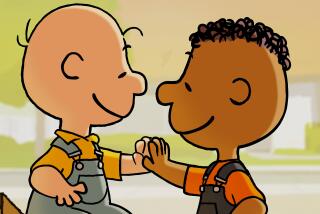Frame after frame, the story of his life
It’s a sad fact of our commercial culture that the real worth of a great thing is often obscured by its own success. Consider “Peanuts,” whose creator is the subject of “Good Ol’ Charles Schulz,” an especially moving “American Masters” documentary airing tonight on PBS. The licensing bonanza Schulz’s comic strip became in the mid-1960s, around 15 years into its half-century run, has continued to this day, its characters made into toys and games and dolls and books and greeting cards; sent out to shill for snack foods and life insurance; given their own theme park. All this recreation of Schulz’s inventions, extraneous almost entirely to his own work and vision, makes an impenetrable crust of their friendly, rounded cuteness.
“Peanuts” was something else, however. Here is the entire text of the first “Peanuts” strip: “Well! Here comes ol’ Charlie Brown! Good ol’ Charlie Brown ... Yes, sir! Good ol’ Charlie Brown. . . . How I hate him!”
The strip was not without whimsy, and Schulz was never too proud to indulge in a warm-puppy sentiment, but its power comes from a darker side without which “Peanuts,” a great work of American literature, might have been no more than a better drawn “The Family Circus” -- a generalized anxiety about life and its challenges that could be understood in completely different ways by readers young and old. Charlie Brown lies in bed wondering, “Why am I here?” “When will it end?” “Where have I gone wrong?” Much of the humor of “Peanuts” springs from the fact that little children speak and think like adults. But these worries are not foreign even to the very young.
As with his creations, Schulz’s own doubt-ridden inner life could be hidden by the outward trappings of his enormous success -- lots of money, a large, good-looking family, a job drawing funny pictures. As in consultant-commentator David Michaelis’ recent biography “Schulz and Peanuts,” director David Van Taylor uses the strips to illuminate the life and the strips to illustrate the life. (Even his marital problems: The demanding, lovelorn Lucy is said to have been based on Schulz’s first wife.) And though it can be a mistake to confuse a person with his art, there seems to be evidence enough that Schulz was -- across 17,987 strips, drawn, inked and lettered exclusively by himself -- writing his emotional autobiography. Certainly, he was his loser-hero Charlie Brown, awkward, shy, the architect of his own isolation (not even his own dog seems to belong to him). But he was also the pianist Schroeder, using his art as a shield, and Linus, spiritual and insecure.
Van Taylor’s film is necessarily a quick sketch of a complicated life, but it moves along nicely (skating along on a piano-driven score a little reminiscent of Vince Guaraldi’s music for the timeless, perfect “A Charlie Brown Christmas”) and makes a convincing case. There are comments from friends, family, fellow cartoonists Jules Feiffer and Lynn Johnston and even early girlfriend Donna Wold, the unachievable, unseen little red-headed girl who haunted Schulz’s strips for nearly 50 years. He came back half an hour after she broke up with him, she recalls, and said, “I thought maybe you had changed your mind.”
--
--
‘American Masters: Good Ol’ Charles Schulz’
Where: KCET
When: 9 tonight
Rating: TV-G (suitable for all ages)
More to Read
The complete guide to home viewing
Get Screen Gab for everything about the TV shows and streaming movies everyone’s talking about.
You may occasionally receive promotional content from the Los Angeles Times.






